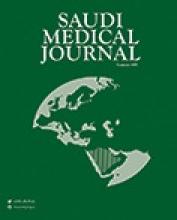Abstract
OBJECTIVE: To elaborate on the epidemiology of hydatid disease in Jordan as a model for the Middle East, and highlight the obstacles that face disease control in the region.
METHODS: The clinical and epidemiological data for 65 patients with the diagnosis of hydatid cyst (who were treated in the Department of Surgery, Jordan University of Science and Technology, Irbid and its affiliated hospitals, between January 1994 through to September 2003) were analyzed. Fifty-five patients were interviewed for details of life style.
RESULTS: Forty-six percent of patients were below 40- years of age. Fifty-seven percent were females. All interviewed patients gave history of contact with dogs and history of ingestion of raw vegetable food. The latter in addition to a high zoonotic infection rate and uncontrolled animal movement were factors contributing to the high prevalence.
CONCLUSION: Optimization of control programs in the Middle East requires the establishment of a regional center. Wide traveling has made it essential for physicians practicing in non-endemic areas to be aware of the diverse presentations of this disease when dealing with immigrants from endemic areas.
- Copyright: © Saudi Medical Journal
This is an open-access article distributed under the terms of the Creative Commons Attribution-Noncommercial-Share Alike 3.0 Unported, which permits unrestricted use, distribution, and reproduction in any medium, provided the original work is properly cited.






